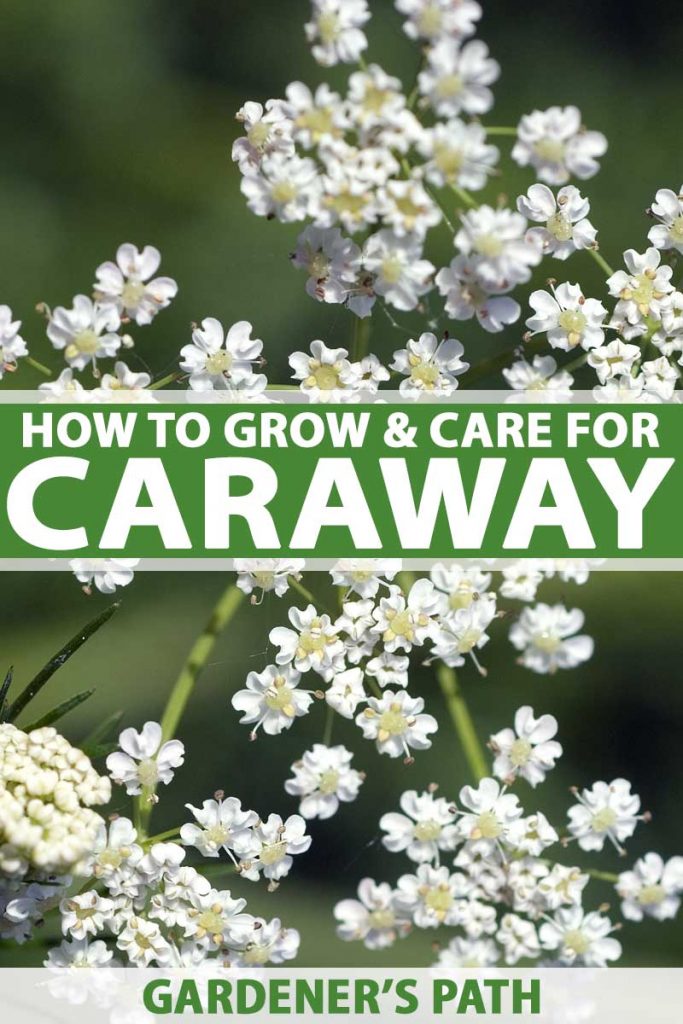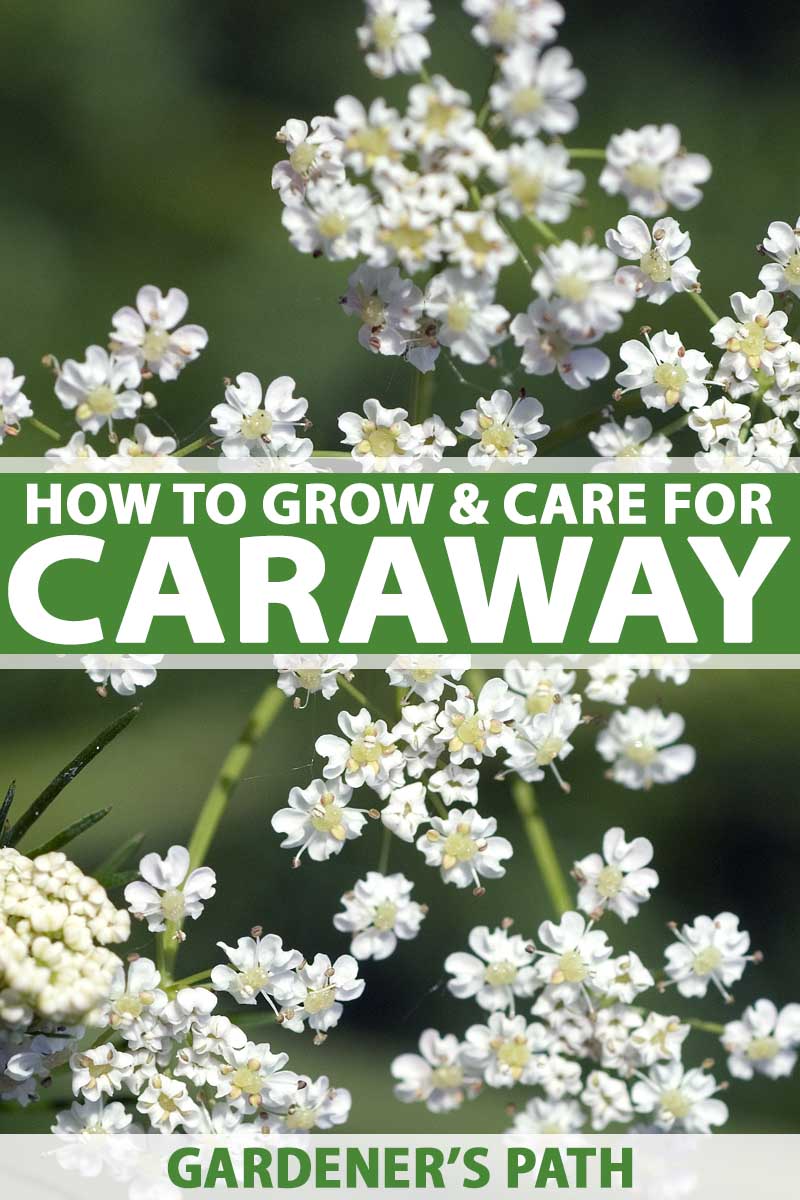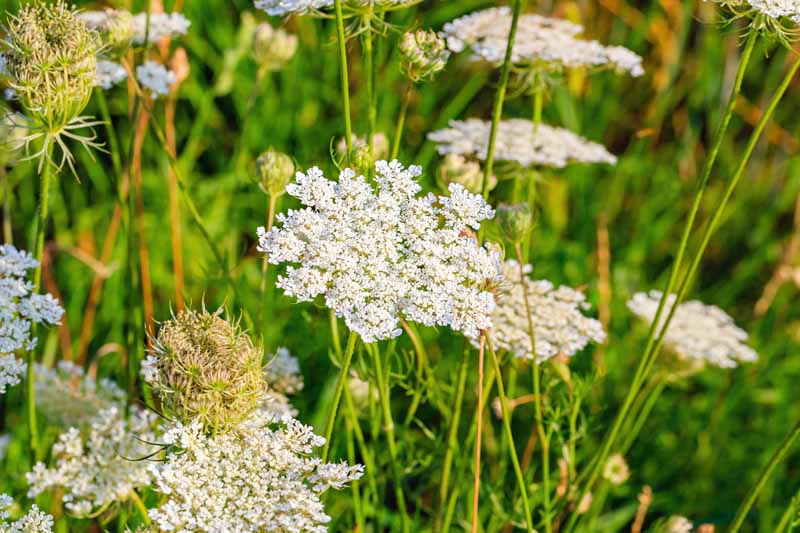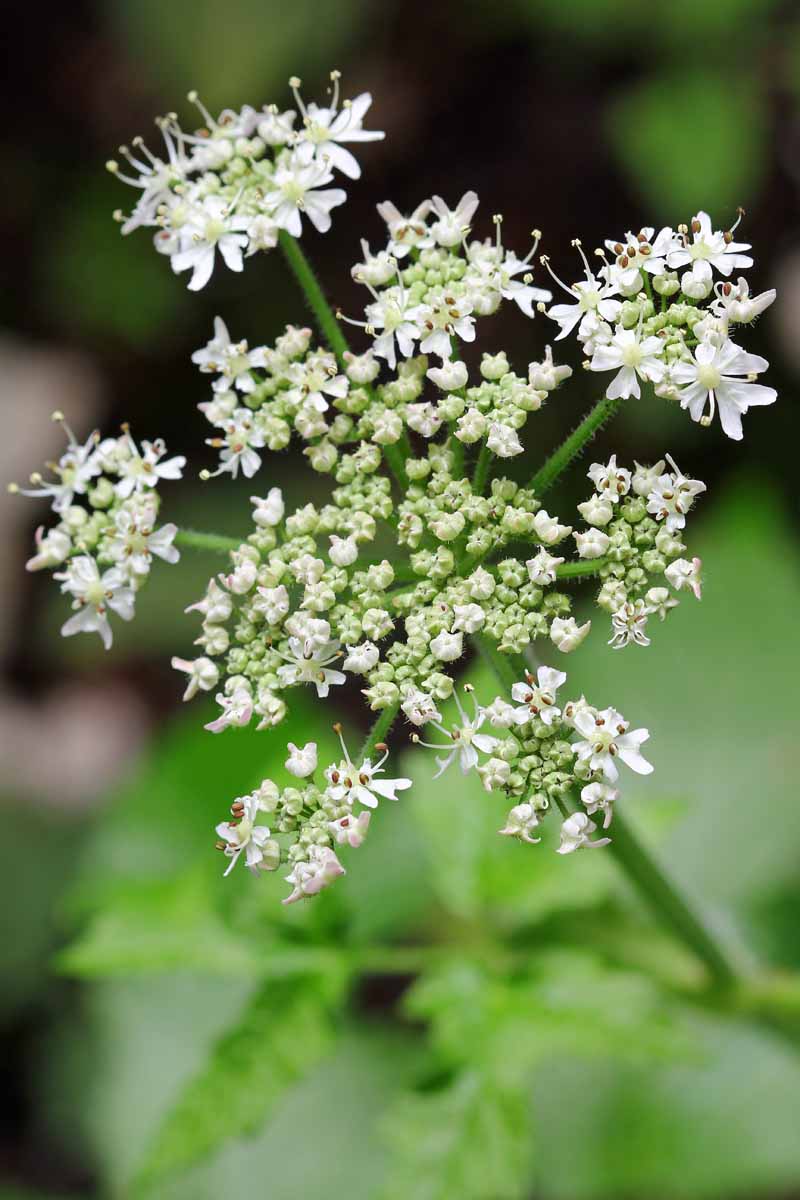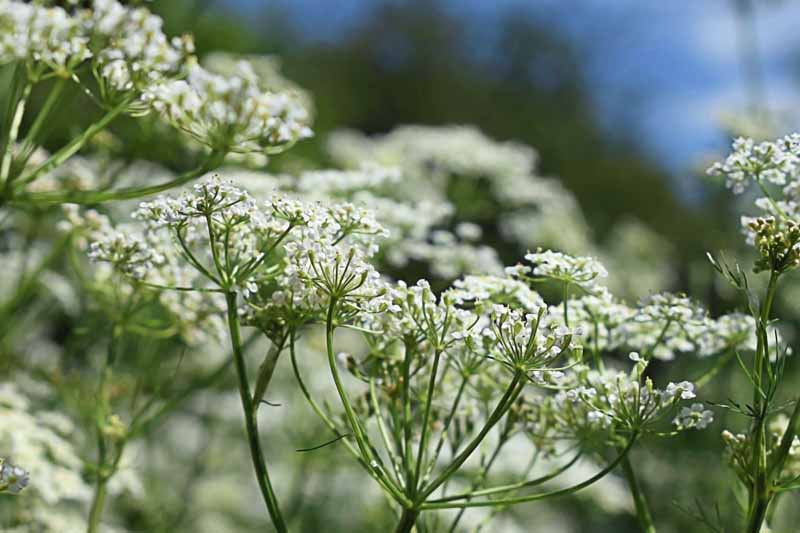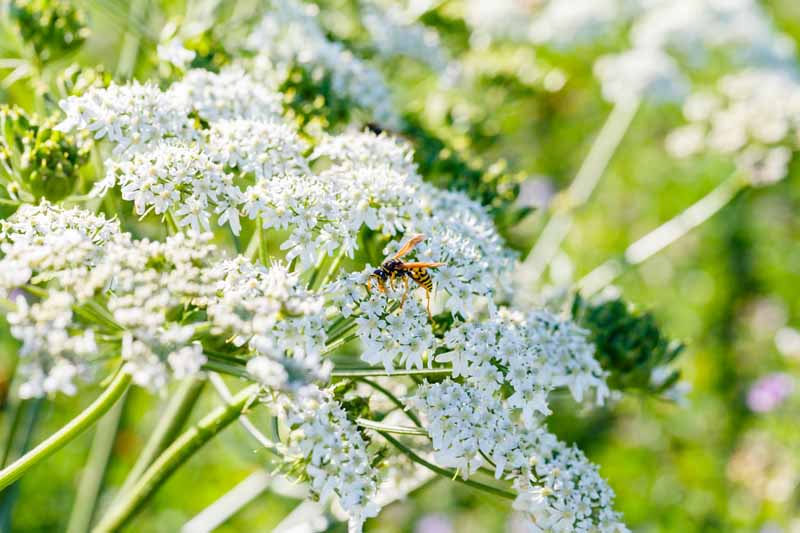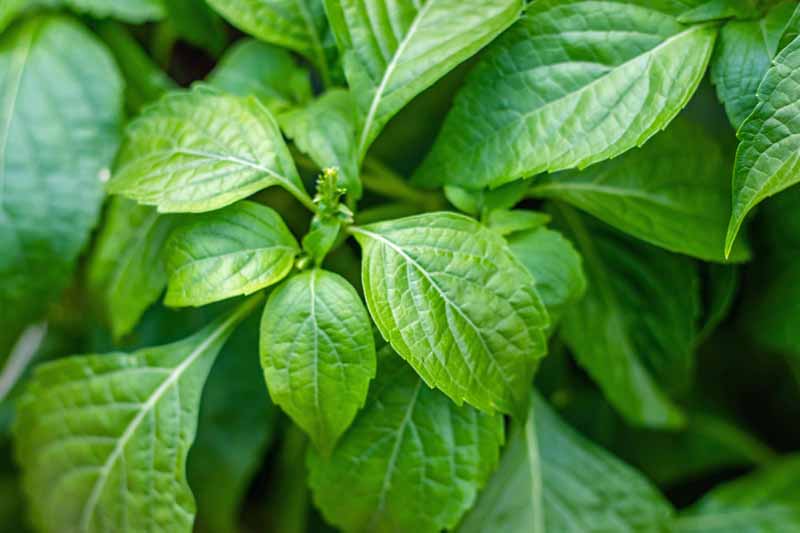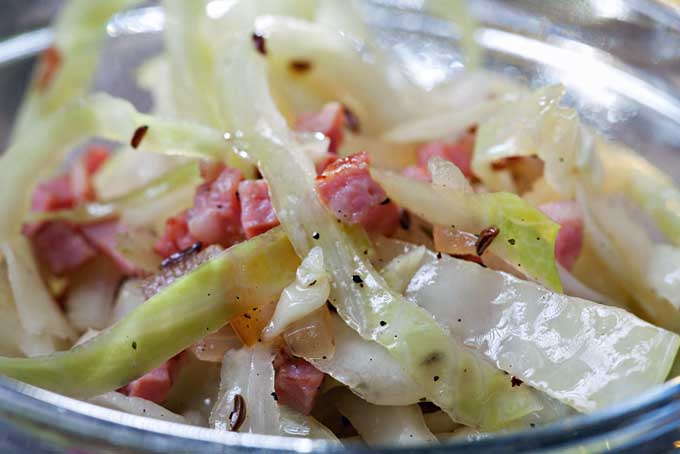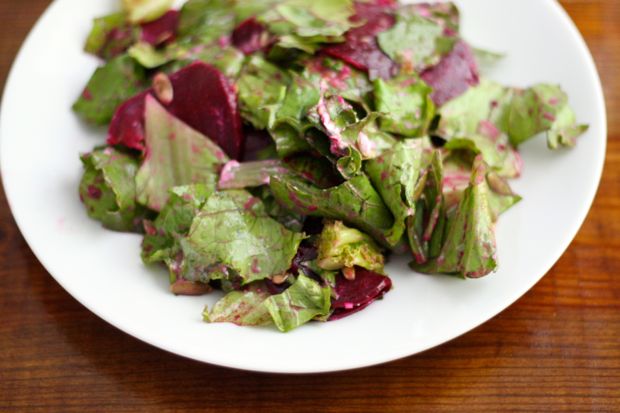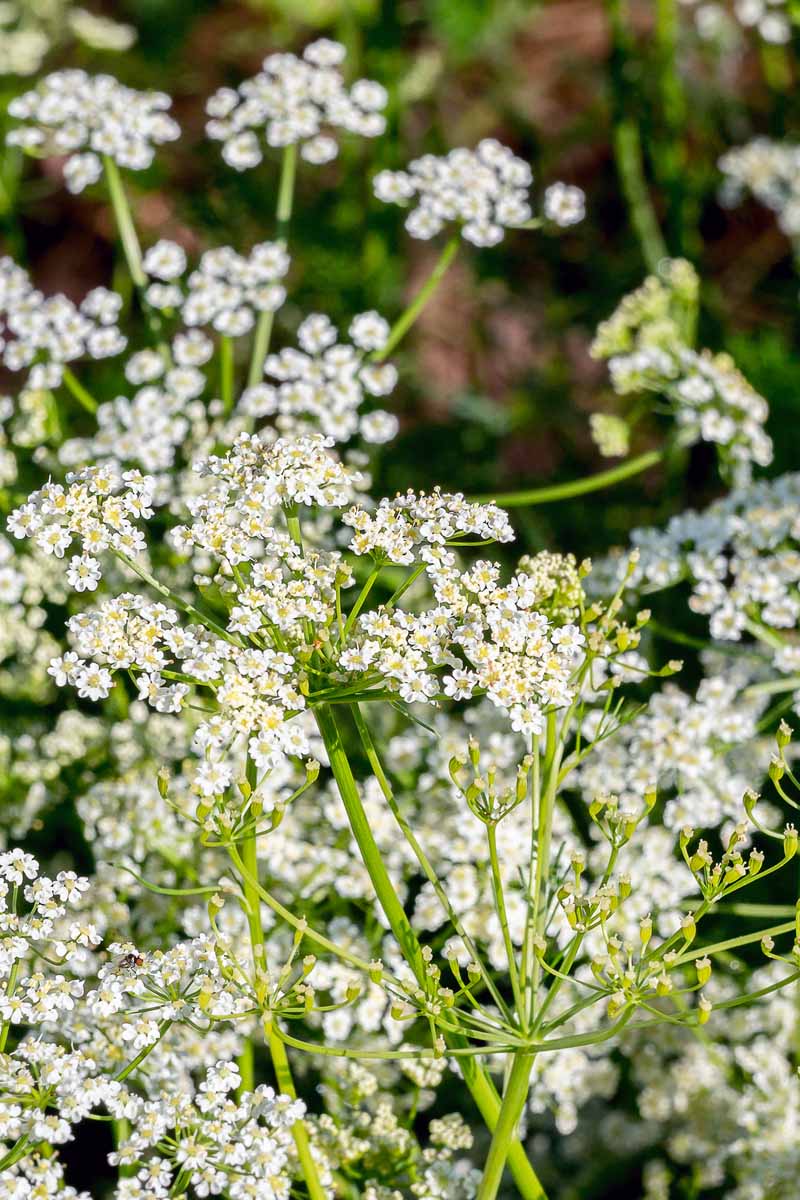We link to vendors to help you find relevant products. If you buy from one of our links, we may earn a commission.
What is Caraway?
Caraway, Carum carvi, is a member of the Apiaceae, or Umbelliferae family that includes celery, carrot, parsnips, fennel, parsley, and other fragrant flowering plants. It is a biennial herb best known for aromatic fruit that is called a seed, and used as a spice. Its flavor is distinctly pungent, with anise and licorice undertones, and has become synonymous with classic rye bread. And while its fruit is the main attraction, the similarly fragrant leaves as well as the roots are also edible.
When you shop for seed to sow, be aware of two unrelated species with similar names. One is caraway thyme, Thymus herba-barona. This is a low-profile herb that’s often used as a ground cover. It’s in the mint, or Lamiaceae family, and its leaves taste like caraway. Another is black caraway, Nigella sativa, in the Ranunculaceae family that includes buttercups, clematis, and columbine. Its seed has a bitter, peppery taste.
Cultivation and History
C. carvi grows in USDA Hardiness Zones 4 to 10. In temperate regions within these zones, those that experience four seasons, it is a biennial that is sown in early spring. In the first year, it produces roots and foliage, and dies to the ground at season’s end. In the second, the foliage becomes bushy, tops out at two feet or more, and produces an “umbel” (think umbrella) arrangement of tiny pink or white florets that make up a flat-topped flower head. At season’s end, the florets wither, giving way to the fruit we refer to as seed.
If it is not harvested, the seed falls and remains dormant until it germinates the following spring. This is called “self-sowing.” In warmer regions, you may raise C. carvi as an annual. When planted in late fall, it flowers and sets fruit the following spring. Also known as meridian fennel and Persian cumin, the use of caraway in culinary and medicinal applications dates to ancient times in Africa, Asia, and Europe. It was a staple crop in Biblical times, and there are references to its cultivation and threshing in the Bible. It has long been appreciated as a digestive aid and a crucial component of magical love potions.
Propagation
C. carvi is a self-fertile herb, so it’s only necessary to have one plant to produce a fruit crop. Pollen is most often dispersed by bees who are attracted to its multiple nectar-rich blossoms. To cultivate this herb in your garden, you’ll need to begin in one of three ways:
Seed
Sprouting seed is the best and most common way to begin. You may start seeds indoors or sow it directly in the garden. Seed packets provide valuable information like days to germination and mature dimensions. Select seed packed for the current year for optimal results.
Seedling
If you visit a local nursery or garden center, or you attend a sale operated by local horticulturists, you may find a seedling among the herbs on offer. It’s not the most common species on the market, because it has a long, fragile taproot. You are more likely to find seed geared to your climate zone.
Cutting
If you’ve got a friend with a plant that’s well underway in the spring, you may snip off a shoot and place it in a glass of water. When you see root formation, carefully transfer it to the garden. This is the most challenging way to start. Let’s find out how to cultivate this aromatic addition to the garden!
How to Grow
Aromatic herbs are a pleasure to have in the garden, and they ask little in return for their flavorful bounty. Here’s what you need to know:
Soil Requirements
Have your soil tested if necessary, to ensure it’s between 6.0 and 7.5, or nearly neutral. The best soil is sandy loam, rich in organic matter, that drains well. Other soil types may be tolerated, provided they are amended with compost to enrich them.
Getting Started
Start seeds indoors four to six weeks before the last average frost date. Be sure to use biodegradable starter pots for easy transferal to the ground, as the tap root is very fragile. If you plan to cultivate in a container, rather than the garden, select one with adequate drainage holes. Fill it with potting soil and sow seed. Start indoors or out, as weather permits. Alternatively, you may direct sow seed, seedlings, or cuttings outdoors, after the danger of frost has passed. Each of these methods results in roots and foliage in the first year, and foliage, flowers, and seed in the second. In warm regions, where caraway grows as an annual, you may sow seed outdoors in autumn, for a crop the following spring. For each method, sow seed to a depth of 1/4 inch. Thin seedlings out, selecting the sturdiest, and leave at least 12 inches between each. Encouraging good air flow inhibits fungus.
Watering, Weeding, and Fertilizing
Promote germination with even moisture. Once established, provide a moderate amount of water. By the second year, plants exhibit fair drought tolerance. Potted foliage dries out faster than in-ground plants. Keep seedlings evenly moist. You may let the soil of well-established vegetation dry out between waterings.
When watering, be sure to aim your hose or watering can at the roots, not the leaves. Wet leaves are an invitation to fungus that you don’t want to extend. For large gardens, consider drip irrigation. Weed diligently to prevent competition for water, and to avoid creating a breeding ground for insect pests and disease. As for fertilizer, a soil test will alert you to nutrient deficiencies in your garden. You may apply a slow-acting, all-purpose, balanced product at the beginning of the growing season.
Companion Planting
C. carvi is an aromatic member of the Umbelliferae family that attracts beneficial insects like bees and hoverflies to its blossoms, helping to control insect pests such as aphids and caterpillars. Consider companion planting with vegetables, especially peas. As a legume, peas function as “nitrogen fixer,” adding essential nitrogen to the soil if you plow them under at season’s end.
Interplanting also helps to keep weeds down, and makes productive use of the “fallow” garden space you have with biennials that don’t produce in the first year.
Cultivation Tips
Caraway is a sound garden investment. It not only provides you with delicious, aromatic seed, it contributes to the biological control of undesirable insects, which is a key component of integrated pest management systems. Now that you’re on your way to producing your first crop, here are six pro tips to keep in mind:
Seed Selection
Managing Pests and Diseases
C. carvi is relatively pest and disease-free, especially if you start with quality seed, your soil drains well, and you keep the weeds down. However, the occasional pest may visit, spreading disease as it feeds.
Caraway Seed vie True Leaf Market You may buy True Leaf Market’s generic seed in 1-ounce, 4-ounce, 1-pound, 5-pound packages. Fall germination is recommended. Some pests to watch for are: carrot rust flies, grasshoppers, leafhoppers, and parsley caterpillars. Diseases include: aster yellows, damping off, phoma blight, and powdery mildew. Read our complete guide for tips and tricks in warding off pests and diseases that affect caraway plants.
Harvesting
It’s fun to go out to the garden and pick something to eat. With caraway, your first harvest may be a few tender young leaves to nibble out of hand or add to a refreshing salad. Later, at season’s end in either year one or two, depending upon whether you are growing as an annual or biennial, the flowers give way to fruit. It dries to become the recognizable seed of which we are so fond, and the foliage withers and dies. At this time, you may harvest both seed and the roots beneath the soil. You can read more about harvest techniques here.
Use and Storage
Here’s how to make the most of all parts of the C. carvi herb when you feature it in your garden:
Leaves
Pick tender young leaves just prior to use. Rinse, and enjoy or toss in salads as desired.
Seed
Seed stays fresh and flavorful for up to four years when stored in an airtight glass jar in a cool, dark, dry location. Do not store it in the fridge or freezer, as moisture may foster mold formation.
Roots
Dig roots at the end of season two, brush the dirt off, and store them like potatoes, in a cool, dry location. Depending upon your climate, they may keep for weeks or months. When you’re ready to enjoy them, simply wash, peel, and cook. Discard any that become soft or deteriorate in any way during storage.
Oil
And if you’re an aromatherapy aficionado, you may want to try your hand at oil extraction, a process that is beyond the scope of this guide.
Caraway Quick Reference Growing Chart
Healthy Recipes to Love
Caraway seed adds a healthy dose of calcium, potassium, and vitamin A to foods. It is rich in essential oil-containing chemical compounds called terpinenes, including limonene and carvone. Their anti-inflammatory properties may prove effective against cancer, diabetes, and osteoporosis, and have been shown to be beneficial to digestion. Visit our sister site, Foodal, for delicious recipes that make use of every part of this nutritious herb. Here are several you are sure to enjoy: In Bavarian Cabbage Salad with Bacon, the fruit of C. carvi is featured to perfection. Serve it warm to fully appreciate the interplay of pungent seed, salty bacon, and subtle vinaigrette. Use the leaves in Beet and Lettuce Salad with Green Onion Vinaigrette for an especially tangy bite with the zing of cayenne and sweetness of maple syrup. And finally, at season’s end in year two, use the roots to good advantage in Roasted Root Veggies, for a hearty helping of sweet and nutty harvest goodness.
Economical, Eco-Friendly Edibles
If you like the taste of caraway, you’re going to absolutely love growing your own. Fresh herbs from the garden make home cooking more flavorful and nutritious, and offer a cost savings over store-bought fresh or dried products.
And cultivating edibles is a sound use of garden space in that it not only puts food on the table, but also contributes to a healthy backyard habitat for pollinators. Get out your garden planner and add a new item to this year’s list: Caraway – the entirely edible herb, with a fruit called a seed, that we eat as a spice! Please tell us about your herb gardening experiences in the comments section below.
